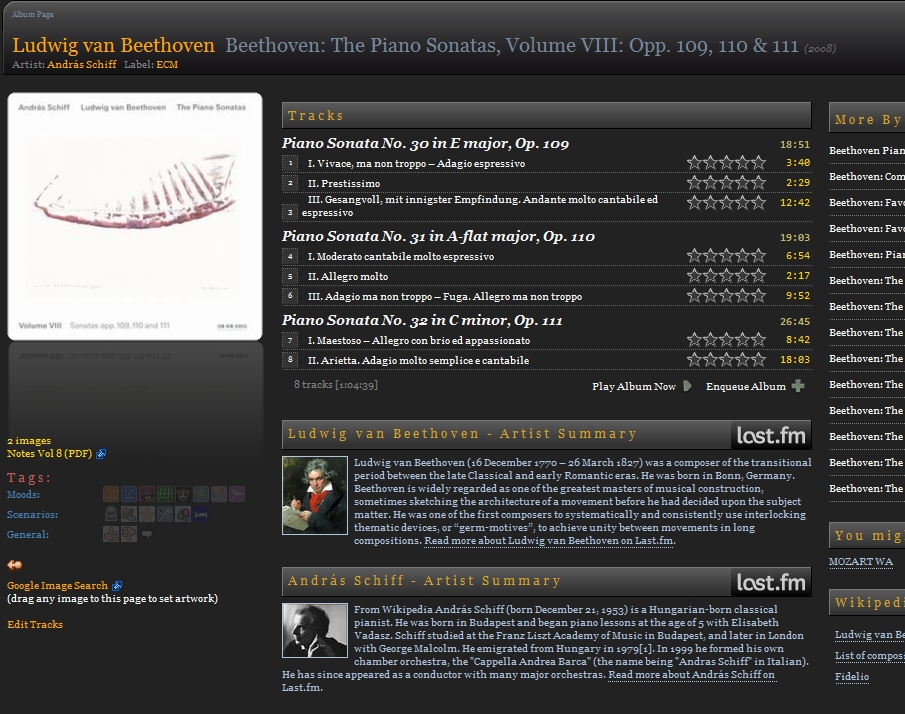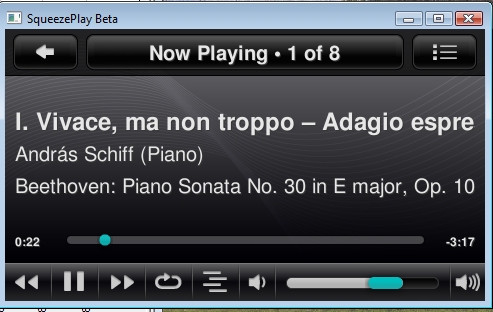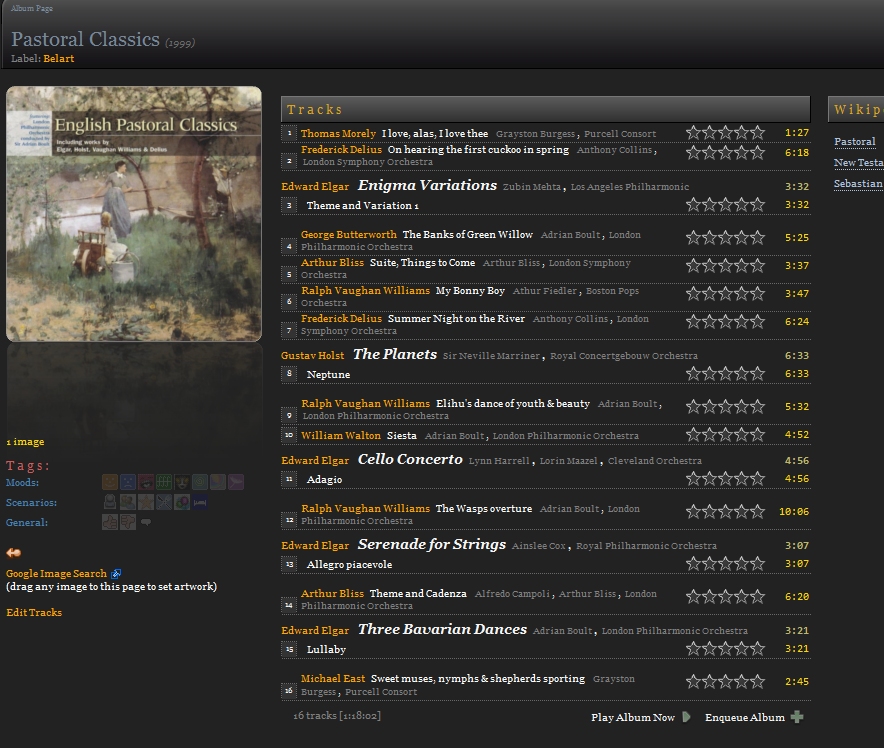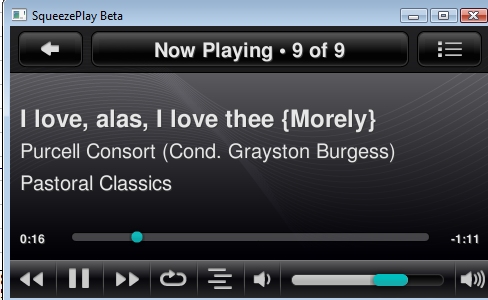Talk:Classical Music Support
Please feel free to add to this discussion. However if you want to edit please make the edit clear.
INTRODUCTION
I'm sure I'm not the only person who has started to rip CDs from their classical music collection and pretty soon got disheartened by the banal fashion with which it is treated by most music software. Practically all the software available is based on a paradigm that says there is a Song by an Artist on an Album. It may allow for a Composer as well, but still assumes that all composers write songs.There should (in theory) be at least two big benefits of ripping your collection: (1) the reduction in shelf space and (2) the ability to quickly locate the music you want. Most software achieves (1) but is not much help as regards (2). At the same time, now that the physical CD case is not to hand when the music is playing, you would like to see some information about it. Frequently this is rudimentary. And of course, you don't want to put in too much work to achieve the required result.This discussion is based on my approach to resolving these problems; an approach which I am sure will evolve over time. At the centre of this is the excellent "Muso" software which, for the first time, gives the classical music lover a "CD Insert" view of their albums coupled with powerful searching and linking facilities, plus an ability to play to either LMS or iTunes.
WHAT'S THE PROBLEM?
There are five main hurdles to be faced in ripping and streaming classical CDs (some of which also apply to jazz albums) in a way that satisfies the music lover, rather than the casual listener.
- Poor availability of metadata, particularly when the album has a variety of ensembles, conductors, soloists, instruments etc.
- Lack of complete structure: failure to deal with the fact that much classical music has movements as parts of larger works which are not the same as physical albums.
- A focus on the Artist rather than the Composer (even assuming the latter is displayed/accessible).
- Player information screens usually limited to Song, Artist and Album.
- Lack of integration of sleevenotes into the experience.
This has meant that either the classical music lover has had to settle for a poor compromise or (in many cases, I suspect) just give up. Even very expensive streaming hardware comes with fairly rudimentarytools for getting value from your CD collection. Unless you have plenty of money and pay someone else to rip your collection for you, the investment of time required to do it, given the quality of the resulting experience, does not seem worth it. I decided to go the Logitech Squeezebox Touch route because at the time it seemed a good value DAC with a flexible software solution. Whilst in retrospect I still think this was a good choice, even with the addition of Custom BrowseI became frustrated and disappointed.
A SOLUTION IN SIGHT
Thankfully it would seem that things are starting to improve. Partly this is because of the growth in the digital download market for classical music and improving metadata libraries. However, the major development for me was the purchase of the "Muso" software which deals with several of the problems described.My approach in outline is now:
- Rip the CDs to FLAC using dBpoweramp CD Ripper. This provides access to the best metadata available on the web, plus artwork. FLAC files are lossless, but compressed to save space, and provide for a limitless number and variety of tags for metadata.
- Review the ripped discs in Mp3tag. I can easily see if tagging errors were made on ripping and correct them. Depending on the type of CD (see details below), I then run an automatic macro action that optimises the tags for Muso and the player software (in my case LMS and iTunes).
- Import the music to the main library and Muso and check it looks right.
- Convert the FLAC files to mp3 using dBpoweramp Batch Converter and import to iTunes (I only do this so that I can sync to my iPod and have a portable version).
- Browse/search music in Muso and queue it to play via LMS on the Squeezebox touch(es). {Alternatively, queue the music to iTunes and then sync the playlist with the iPod to play in the car etc.}
This still involves a bit of human review along the way, particularly to fix any shortcomings in the available metadata and each action stage needs to be initiated manually, so a little organisation is required.
Take a look at the #THE_PAYOFF section to see what the result looks like.
THE DETAILS
So to the nuts and bolts.
The key to everything is the metadata structure, so that is discussed in some detail first, followed by further details of each of the steps described above.Before considering the detailed tags, I think it is useful to consider the macro-level structure of the actual CDs and what we are trying to achieve with each.
Types of CD
In order to optimise the use and display of tags, two major types of CD are identified (each with a variant). {Note that the term "CD" is taken to be any album set which forms a unit, so it could be more than one physical disc.}
"Opus" (and "Book") types
These are CDs where the works are generally multi-movement. A tag will be defined for both the Opus and the Movement. On the web-sourced metadata, the Title is typically "Opus: Movement", although I note that a certain high-end purveyor of hardware and dowloadable studio-quality music uses "Opus - Movement" and then uses further hyphens in the movement itself. For large works (e.g. operas) where the CD (or box set) is just that work, then it is useful to define the work in more than one level: "Book" is used for the top level and "Opus" for the lower level. For example, in Handel's Messiah, the Book might be "Messiah" and the Opus "Part I". The plan is that Muso will display a nice hierarchical structure just like the CD insert. On playing in LMS/iTunes, the Album will be the name of the Opus (or "Book - Opus") prefixed by the Composer.
"Song" types (one or more composers)
These are "simple" albums with no hierarchy. They will just be displayed as lists in Muso. For single-composer albums, the composer name will prefix the album, otherwise it will be in a suffix to the title.
Tags
FLAC files allow any tag names, and any number of them, to be used. The actual names are not important unless they are "standard" tags used in particular ways by particular software (including Muso). See Attribute_Mapping for details of standard tags. My basic philosophy is to use "custom" tags for the key metadata and then (re-)construct the standard tags from these. As much as possible, this process is automated. In this way, the standard tags can always be re-configured as software requirements and capabilities change. Re-tagging is an activity to be avoided. Mp3tag is used to facilitate this.
The tags and how they are derived and used are set out below. The sequence shown is the one that I use in the "panel" in Mp3tag (although I do not display them all, the others can be accessed via "extended tags"). Multiple entries in tags should be separated by ; (NB do not use any ; in string in a tag except to separate multiples).
Title
Derived from:- Web-sourced metadata.
Initially, on ripping, this should be the opus (if any) followed by the movement, separated by a colon. This is a (fairly) standard naming convention for classical tracks. Check that only one colon is present.The tag is subsequently modified for display purposes.
Artist
Derived from:- Web-sourced metadata.
For displaying on the player, the names of all significant performers are required. This is built automatically by an Mp3tag action. When ripping, this tag should only contain the name of the principal soloist (or maybe two, for duets etc.). The orchestra, conductor, composer etc. are in other tags.
Artist Sort
Derived from:- Web-sourced metadata.
This should be created on ripping by Metadata in Options setting. Check it reflects the artist.
Album
Derived from:- Web-sourced metadata. Will require editing and is subsequently changed by tagging actions.
Initially this should be exactly the name of the CD or box set that you want to see under Muso. However, there is merit in using a prefix of "Composer(s): " as this helps to sequence folders and playlists (see further details below). For "Opus" type albums we are aiming for an eventual display of "Composer: Opus" or "Composer: Book - Opus".
Genre
Derived from:- Web-sourced metadata. May require editing.
I use a classical sub-type (see box 3 - tbc) for all works where composer/conductor are key. Otherwise 'Rock' etc. Do not use "Classical". The alternative is to use another tag for sub-genre. [EDIT REQUIRED]
Comment
Derived from:- User.
Any additional information about the album (shows in Album sub-header in Muso).
Album artist
Leave blank. Interpreted differently by software. Muso will infer from other tags. For Muso to group the album together, the "folder" option needs to be selected in the database edit. For classical albums, Muso will treat the composer as the Titled Artist if the composer is the same on every track. See also http://wiki.hydrogenaudio.org/index.php?title=Foobar2000:Encouraged_Tag_Standards#ALBUM_ARTIST .
Composer
Derived from:- Web-sourced metadata.
Full name. Use hyphens etc. to prevent splitting words on sorting.
Composersort
Derived from:- Web-sourced metadata or automatic from Composer
Surname, First name (if not present, it will be created later by Mp3tag action)
Composerlastname
Derived from:- Automatically from ComposerSort
Surname
Arranger
Derived from:- User.
Name of arranger, if any. Generally not shown separately in web-sourced metadata.
Period
For Classical Genre: Medieval, Renaissance, Baroque, Classical, Romantic, Modern. For other (popular) genres: decade (e.g. 1970s). Can be left for Muso to work out from Composer.
Book
Derived from:- User.
Larger body of work (see notes above).
Opus
Derived from:- Automatically from Title.
Name of work. Should be identical with the first part of the title. If an opus just comprises a single track, then the opus and title can be identical [EDIT - CHECK THIS] (mp3tag action creates automatically, so get it right in the Title when ripping). Check to see if the opus appears elsewhere in the collection and use consistent naming. Also use opus numbers and catalogue numbers (plus wikipedia to check official opus names if nec. - see http://www.jsbach.org for Bach BWVs and titles).
Band
Derived from:- Web-sourced metadata or user.
Name of the Orchestra or group (multiple bands supported, separated by semicolon)
Conductor
Derived from:- Web-sourced metadata or user.
Conductor's full name.
Mainperformer
Derived from:- Automatically from Artist.
The main artist for the track. Not Band or conductor here (possible exception if the conductor is also playing as lead artist/director).
Instrument
Derived from:- Web-sourced metadata or user.
The instrument of the MainPerformer, if relevant. If more than one MainPerfomer, then list instruments in the same order.
Performer
Derived from:- Web-sourced metadata or user.
Name of any soloists or other featured individuals other than the main performer (separate by semicolons). Include instrument in brackets if required.
CDName
Derived from:- Automatically from Album.
This is then used as the source of the album name in Muso and the playlist in iTunes.
Movement
Derived from:- Automatically from Title.
Section of the work. Should be identical to the second part of the title (mp3tag action creats automatically, so get it right in the Title when ripping).
Work
Derived from:- Automatically from "Book - Opus"
An intermediate tag. Also used to feed "Style" tag on conversion to mp3 which feeds iTunes Grouping.
The Process
This section sets out my process for ripping, retagging and importing classical music.
Step 1: Rip the CD's
Read the CD, using dBpoweramp CD Ripper. It will be ripped to a folder such as: Music\Newly-Ripped CDs. Each CD (or set) will have its own folder. Multiple discs will be in sub-folders. A pre-defined "profile" in dBpoweramp is used to do this, giving the files a filename of "\[album]\[IFMULTI]Disc [disc]\[track] [title]". This Profile also should set metadata and tag ID options to create sorted composer tags etc. plus create new tags (in options) for Opus, CDName (=Album), Movement, Period, Instrument.
NB: Before ripping it:
- Amend Album name, if necessary, to begin with Composer or other lead artist(s) surname, followed by colon, then the album name (or works on it). Do not include Disc number.
- Scan artwork if necessary.
- Review metadata and ensure consistency with metadata rules (see above). Make sure that Genre is correct and that Title is in the format "Opus: Movement". Make sure that multiple disc sets have the right discnumber tags. Add metadata where missing (no need to enter Movement or Opus as it can be created from Title); usually this means Period and Instrument.
Rip the CD. On ripping, dBpoweramp should be set up to map Album to CDName, Soloists to Performer, Artist to MainPerformer, Chorus and Orchestra to Band. It also deletes the Album Artist tag as this should only be used exceptionally (it can be manually re-set in Mp3tag in the next step). Replaygain and other effects can be applied as required.
Step 2: Review and amend the metadata
Use mp3tag to review the metadata. Set up the panel to view all the important fields. This makes everything quicker. In particular, check that the main artist appears as "MainPerformer" and not also as "Performer". Check "Period" and "Instrument" tags are present and correct. If necessary put supporting performers in the "Performer" tag separated by semi-colons and with instrument/voice in brackets: "Peformer1 (Instrument1); Performer2 (Instrument2)". Put any arranger into the "Arranger" custom tag. These last two steps are of course optional, but it's not hard to do them at this stage. Also, if you really need an Album Artist tag you can enter it now.
IMPORTANT - make sure you save before selecting other tracks - Mp3tag does not remind you to do this!
Then run one of the following actions:
- For "Opus" profile, use "Format Profile=Opus". Through this action, the Title should be the Movement and the Album should be "Composer: Opus". "Work" will be set = Opus unless there is also a "Book" tag, when it is "Book - Opus" (not normally required, but could be useful if wanting to reduce length of GroupHeading in Muso).
- For "Book" profile, use "Format Profile=Book". In this case make sure you have previously entered the Book name as a tag for all tracks. "Book" is usually the name of the Opera etc. The Title should then be changed by the action to Opus: Movement, where "Opus" is the sub-part of the Book. The Album should become Composer:Book. "Work" will be "Book - Opus"
- For "Song" profile, use "Format Profile=Song". Through this action, the Title should be "Song (Composer)" and the Album should be the CDName.
- For "Song" profile, where all songs are by one composer, use "Format Profile=Song (one composer)". In this case the composer name is omitted from the song title for display purposes.
You may feel that some albums don't clearly fall into just one of these categories. For example, there may be one opus of 3 movements and then a number of single movement works: in this case, if you use the "song" profile, it will still set up a GroupHeading in Muso for the multi-movement work. It is also possible to use more than one profile for different parts of the album, but you may also wish to amend the album name (not the CDName) to suit. In all cases, "Artist" should be "MainPerformer (Instrument); Band (Cond: Conductor); Feat: Performer1 (Instrument1) etc. This displays all the artist info on the SB touch or iPod. Arranger will also be added where appropriate to the Title or Album.
For the detailed actions contained in these see Box [] below. Note that these actions are (hopefully) designed such that integrity is maintained even if they are run multiple times (i.e. no duplicated tags etc.).
Check that the resulting metadata looks correct.
Step 3: Import the files to Muso / LMS
In my set-up, there are two libraries - the main FLAC library is used at home to play via LMS to Squeezebox touches. This is set up as the "Shared Database" as follows. Assuming the main music library is on a shared drive, place the folder with the ripped files in the library, set Muso to use the shared database and import to Muso using "Import from specific folder". Import actions are required as follows to ensure that the right information is displayed in Muso:
- Album := #CDName (Mark this as conditional - to deal with music not associated with a physical CD)
- GroupHeading := #Opus
- Artist := (Arr. #Arranger); (Mark this as conditional - to place the arranger's name after composer and before the artist, if it exists)
- Artist := Mainperformer (This is the original artist name, moved to Mainperformer to allow the Artist field to display all artists)
- Album Artist := #Blank (Optional - in case album artists have not been removed - to allow Muso to use it's own algorithm for displaying the "titled artist"
- AlbumSubheader := #Comment
- Performer = #Performer
Review the imported files to make sure that it they look right. The files can also be scanned into LMS, although this is not essential unless you want to sync ratings etc. to LMS and use the LMS menus.
Step 4: Import to iTunes (if required)
If, like me, you want a (smaller) version of your library to keep on your iPod etc., then it is fairly simple to import it to iTunes and still be able to find the music by album or opus.
Step 4a)Use dBpoweramp Batchconverter to convert files to mp3. Make sure that tagging is set to ID3v2 in dBpoweramp Configuration Codec Advanced Settings. Map WORK tag to Style on conversion (using ID tag processing DSP).Use filename profile of "\[tag]CDNAME[][IFMULTI]\Disc[disc][]\[track] [title]" to follow required location of the iTunes music library. Use a DSP to preserve .jpg and .pdf files for artwork and sleevenotes.
Step 4b) In Muso options, switch to the "personal database" (assuming you are using two libraries). Import the mp3 files to Muso using "import specific folder" and the same import actions as for the FLAC files. (NB mp3 tags are fussy about capitalization, unlike FLAC tags, so all the mp3tag actions finish with one to make sure that the capitalization is consistent - i.e. and initial capital only, except for CDName). Check that it looks right in Muso.
Step 4c)From within iTunes, "File - Add Folder to library". NB ensure preferences are set (Advanced tab) to not let iTunes manage the library. The folder list can be sorted by date to find the recently added ones.Now go to Muso options (configuration) and switch to the personal database. Import the folder (as "import specific folder" not as "import iTunes" - this is necessary to get the custom tags). Now select iTunes asthe player and queue the album to play. In "edit tracks", copy the name of the album. Now go to iTunes and select the "muso playlist". Select all the tracks and create a new playlist from the selection - paste the album name into the title, press enter and "done". Move the new playlist to the "CDs" playlist folder.
Step 4d)Sync to the iPod.CDs can now be accessed by original album name from the Playlist or as Opus's from the Album list.
THE PAYOFF
So what have we achieved? Hopefully the following:
- All the important metadata is stored in custom tags so that the other tags can always be (re)-created to suit future applications;
- Muso will display the original album in "CD insert" format, together with all the supplementary data from LastFM etc.;
- Muso will allow you to drill down and search the library for whatever you want;
- The squeezebox touches will display all the relevant information about the playing track;
- iTunes will show the opus as album, but the original CD is accessible as a playlist.
The actual effort to rip each CD is fairly low, provided you use all the automated actions in Mp3tag.
Here is a typical "opus"-type album. The Muso screen looks just like the CD insert. Notice how tracks are grouped by opus:
On the SB touch the display will be similar to the Squeezeplay one shown below - notice that the instrument is added in brackets after the artist name and the album name gives the composer and work, not the original CD name:
The next screen shows the Muso display for a "song"-type album. Note that if titles are formatted as "opus: movement" then the opus will be displayed as a Group Header even though the profile for the album is "song":
On the SB touch it looks like this - note how the composer is added in brackets after the song:
RESOURCES
(To complete - this section will give details of all the Mp3tag actions etc.)



